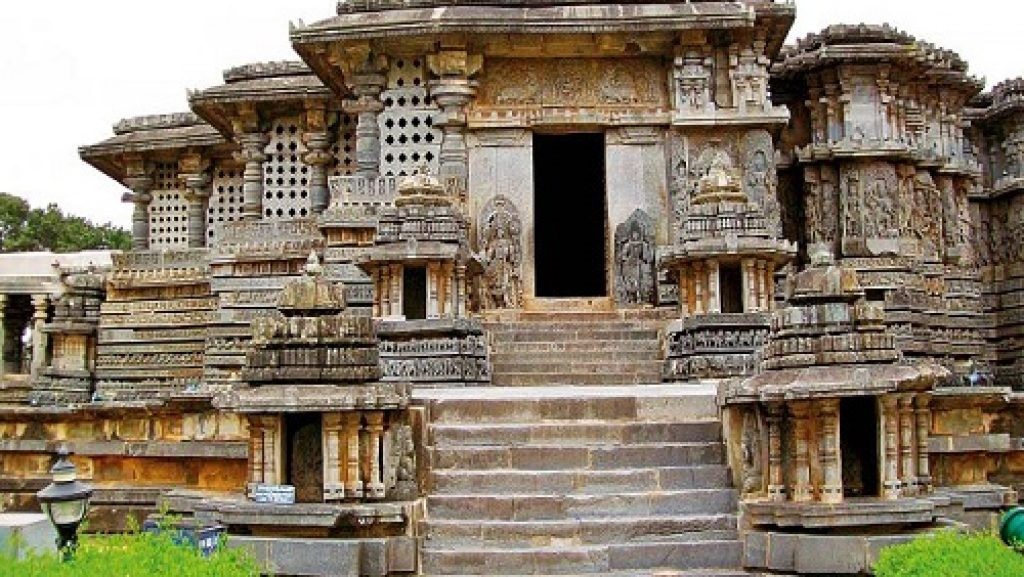Introduction
The Vesara Style Temples represent a unique architectural synthesis that emerged in medieval India, blending the grandeur of Dravida (South Indian) and Nagara (North Indian) styles. Flourishing primarily in the Deccan region, especially Karnataka, this style showcases the artistic ingenuity of dynasties like the Chalukyas, Rashtrakutas, and Hoysalas. From the intricate carvings of Halebidu to the majestic towers of Pattadakal, Vesara architecture stands as a testament to India’s cultural confluence.
Historical Background of Vesara Architecture
The term “Vesara” is believed to derive from the Sanskrit word vishra, meaning “an area to take a walk,” symbolizing its hybrid nature. It was first conceptualized during the Chalukya dynasty (6th–8th century CE), who ruled from Badami in Karnataka. Their experimentation with temple forms laid the foundation for Vesara architecture, which was later refined by the Rashtrakutas and perfected by the Hoysalas.
Origin and Evolution
Under the Chalukyas
- Early Vesara temples emerged in Aihole, Badami, and Pattadakal.
- The Virupaksha Temple at Pattadakal is a prime example, built by Queen Lokamahadevi to commemorate her husband’s victory over the Pallavas.
Rashtrakuta Contributions
- The Kailasanatha Temple at Ellora, carved from a single rock, reflects Vesara elements with its Dravidian plan and Nagara-style superstructure.
Hoysala Refinement
- Temples at Belur, Halebidu, and Somnathpura exhibit star-shaped plans, ornate sculptures, and soapstone construction—hallmarks of Hoysalas Vesara style.
Geographical Spread
While Vesara architecture is most prominent in Karnataka, its influence extended to:
- Andhra Pradesh – Temples in Alampur and Kadapa show Vesara traits.
- Maharashtra – Ellora and other Rashtrakuta sites.
- Telangana – Kakatiya temples show transitional Vesara elements.
Key Architectural Features of Vesara Style Temples
- Fusion of Nagara and Dravida styles: Curvilinear shikharas with stepped vimanas.
- Antarala (vestibule): Connects the sanctum and mandapa.
- Stellate (star-shaped) plans: Especially in Hoysala temples.
- Intricate carvings: Depicting epics, deities, and daily life.
- Multiple shrines: Trikutachala layout with shared mandapas.
- Material: Use of soapstone and sandstone for detailed sculpting.

Symbolism & Cultural Significance
Vesara temples were not just architectural marvels—they were spiritual centers. Their hybrid design symbolized:
- Unity in diversity: Merging northern and southern traditions.
- Cosmic geometry: Star-shaped plans representing divine order.
- Devotional storytelling: Sculptures narrating Ramayana, Mahabharata, and Puranic tales.
Comparison with Nagara & Dravida Styles
| Feature | Nagara Style | Dravida Style | Vesara Style Temples |
|---|---|---|---|
| Region | North India | South India | Deccan (Central India) |
| Tower (Shikhara/Vimana) | Curvilinear Shikhara | Stepped Pyramid Vimana | Hybrid: Curved + Stepped |
| Plan | Square or Rectangular | Square with axial mandapas | Stellate or star-shaped |
| Material | Sandstone | Granite | Soapstone, Sandstone |
| Ornamentation | Moderate | Heavy | Extremely intricate |
| Circumambulatory Path | Present | Present | Often absent |
Famous Vesara Style Temples
1. Virupaksha Temple, Pattadakal
- Built by Queen Lokamahadevi.
- Inspired by Kailasanatha Temple at Kanchipuram.
2. Mallikarjuna Temple, Pattadakal
- Smaller twin of Virupaksha.
- Rich in Dravidian ornamentation.
3. Hoysaleswara Temple, Halebidu
- Dedicated to Lord Shiva.
- Features lathe-turned pillars and mythological friezes.
4. Chennakesava Temple, Belur
- Built by Vishnuvardhana.
- Celebrates victory over the Cholas.
5. Kailasanatha Temple, Ellora
- Rashtrakuta masterpiece.
- Carved from a single rock.
Regional Variations
- Northern Karnataka: Chalukyan temples with stepped vimanas.
- Southern Karnataka: Hoysala temples with stellate plans.
- Maharashtra: Rashtrakuta rock-cut temples.
- Andhra Pradesh: Transitional Vesara forms in Kadapa and Alampur.
Influence on Later Architecture
Vijayanagara Style
- Adopted Vesara features like ornate mandapas and hybrid vimanas.
- Temples at Hampi show Vesara influence in layout and sculpture.
Beyond Vijayanagara
- Vesara principles echoed in Maratha and Mysore temple designs.
- Continued use of star-shaped plans and sculptural storytelling.
🏛️ Modern Relevance & Preservation
- UNESCO World Heritage Sites: Pattadakal and Hampi.
- Tourism: Karnataka temple architecture draws global visitors.
- Conservation Efforts:
- Archaeological Survey of India (ASI) maintains key sites.
- Digital documentation and 3D modeling underway.
FAQs on Vesara Style Temples
1. What is the Vesara style of temple architecture?
It’s a hybrid style combining Nagara and Dravida elements, prominent in Deccan temples.
2. Which dynasties promoted Vesara architecture?
Chalukyas, Rashtrakutas, and Hoysalas were key patrons.
3. Where can I see Vesara style temples?
Pattadakal, Halebidu, Belur, Ellora, and Somnathpura are prime locations.
4. What materials were used in Vesara temples?
Soapstone and sandstone were commonly used for intricate carvings.
5. How is Vesara different from Nagara and Dravida styles?
It blends features of both—curved towers from Nagara and stepped vimanas from Dravida.
6. Are Vesara temples still active places of worship?
Yes, many like Virupaksha Temple continue to host rituals and festivals.
Key Takeaways
- Vesara Style Temples are a fusion of Nagara and Dravida architecture.
- Originated under Chalukyas and flourished with Hoysalas.
- Found mainly in Karnataka, with extensions into Maharashtra and Andhra.
- Known for star-shaped plans, intricate carvings, and hybrid towers.
- Influenced later styles like Vijayanagara and remain vital to India’s heritage.
Conclusion
The Vesara Style Temples stand as enduring symbols of India’s architectural innovation and spiritual depth. Their harmonious blend of Nagara and Dravida influences, coupled with regional creativity, makes them a cornerstone of Karnataka temple architecture. Whether you’re a historian, devotee, or traveler, exploring these temples offers a journey through centuries of cultural brilliance.